Remote Sensing of Floodwater-Induced Subsurface Halite Dissolution in a Salt Karst System, with Implications for Landscape Evolution: The Western Shores of the Dead Sea
Abstract
:1. Introduction
2. Geomorphological and Hydrogeological Background
2.1. The Dead Sea (DS) Basin
2.2. Ze’elim Fan
2.3. Hever Fan
3. Data and Methods
3.1. Airborne LiDAR
3.2. InSAR
3.3. Drone Photography
3.4. Time-Lapse Cameras
3.5. Canal Overpass Hydrometers
4. Results
4.1. Ze’elim Fan
4.1.1. Landscape Evolution in Response to Flash Floods
4.1.2. Subsurface Water Pathways and Dissolution Channels
4.2. Hever Fan
4.3. Subsurface Dissolution Channels in Rahaf Fan—Lynch Straits
5. Discussion
5.1. Temporal Development of the Shoreline Karst Systems
5.2. Flood-Related Subsidence Mechanisms
5.3. Dynamics of Flood-Related Karst Evolution and Landscape Changes along the DS
5.4. Implications for Sinkhole Hazard Assessment
6. Summary and Conclusions
Supplementary Materials
Author Contributions
Funding
Data Availability Statement
Acknowledgments
Conflicts of Interest
References
- Frumkin, A. New Developments of Karst Geomorphology Concepts. In Treatise on Geomorphology; Frumkin, A., Ed.; Elsevier: Amsterdam, The Netherlands, 2013; pp. 1–13. ISBN 978-0-08-088522-3. [Google Scholar]
- Gutiérrez, F.; Parise, M.; De Waele, J.; Jourde, H. A Review on Natural and Human-Induced Geohazards and Impacts in Karst. Earth-Sci. Rev. 2014, 138, 61–88. [Google Scholar] [CrossRef]
- Avni, Y.; Lensky, N.; Dente, E.; Shviro, M.; Arav, R.; Gavrieli, I.; Yechieli, Y.; Abelson, M.; Lutzky, H.; Filin, S.; et al. Self-Accelerated Development of Salt Karst during Flash Floods along the Dead Sea Coast, Israel. J. Geophys. Res. Earth Surf. 2016, 121, 17–38. [Google Scholar] [CrossRef]
- Shviro, M.; Haviv, I.; Baer, G. High-Resolution InSAR Constraints on Flood-Related Subsidence and Evaporite Dissolution along the Dead Sea Shores: Interplay between Hydrology and Rheology. Geomorphology 2017, 293, 53–68. [Google Scholar] [CrossRef]
- Gutiérrez, F. Gypsum Karstification Induced Subsidence: Effects on Alluvial Systems and Derived Geohazards (Calatayud Graben, Iberian Range, Spain). Geomorphology 1996, 16, 277–293. [Google Scholar] [CrossRef]
- Benito, G.; Pérez-González, A.; Gutiérrez, F.; Machado, M.J. River Response to Quaternary Subsidence Due to Evaporite Solution (Gállego River, Ebro Basin, Spain). Geomorphology 1998, 22, 243–263. [Google Scholar] [CrossRef]
- Guerrero, J.; Gutiérrez, F.; Lucha, P. Impact of Halite Dissolution Subsidence on Quaternary Fluvial Terrace Development: Case Study of the Huerva River, Ebro Basin, NE Spain. Geomorphology 2008, 100, 164–179. [Google Scholar] [CrossRef]
- Parise, M.; Gunn, J. Natural and Anthropogenic Hazards in Karst Areas: An Introduction. Geol. Soc. Lond. Spec. Publ. 2007, 279, 1–3. [Google Scholar] [CrossRef]
- De Waele, J.; Gutiérrez, F.; Parise, M.; Plan, L. Geomorphology and Natural Hazards in Karst Areas: A Review. Geomorphology 2011, 134, 1–8. [Google Scholar] [CrossRef]
- López-Chicano, M.; Calvache, M.L.; Martín-Rosales, W.; Gisbert, J. Conditioning Factors in Flooding of Karstic Poljes—The Case of the Zafarraya Polje (South Spain). Catena 2002, 49, 331–352. [Google Scholar] [CrossRef]
- Delle Rose, M. Sinkhole Flooding and Aquifer Recharge in Arid to Dry Sub-Humid Regions: A Systematic Review in the Perspective of Climate Change. Hydrology 2022, 9, 25. [Google Scholar] [CrossRef]
- Bonacci, O.; Ljubenkov, I.; Roje-Bonacci, T. Karst Flash Floods: An Example from the Dinaric Karst (Croatia). Nat. Hazards Earth Syst. Sci. 2006, 6, 195–203. [Google Scholar] [CrossRef]
- Bailly-Comte, V.; Jourde, H.; Roesch, A.; Pistre, S. Mediterranean Flash Flood Transfer through Karstic Area. Environ. Geol. 2008, 54, 605–614. [Google Scholar] [CrossRef]
- Bailly-Comte, V.; Jourde, H.; Roesch, A.; Pistre, S.; Batiot-Guilhe, C. Time Series Analyses for Karst/River Interactions Assessment: Case of the Coulazou River (Southern France). J. Hydrol. 2008, 349, 98–114. [Google Scholar] [CrossRef]
- Najib, K.; Jourde, H.; Pistre, S. A Methodology for Extreme Groundwater Surge Predetermination in Carbonate Aquifers: Groundwater Flood Frequency Analysis. J. Hydrol. 2008, 352, 1–15. [Google Scholar] [CrossRef]
- Tsui, P.C.; Cruden, D.M. Deformation Associated with Gypsum Karst in the Salt River Escarpment, Northeastern Alberta. Can. J. Earth Sci. 1984, 21, 949–959. [Google Scholar] [CrossRef]
- Seijmonsbergen, A.C.; De Graaff, L.W.S. Geomorphological Mapping and Geophysical Profiling for the Evaluation of Natural Hazards in an Alpine Catchment. Nat. Hazards Earth Syst. Sci. 2006, 6, 185–193. [Google Scholar] [CrossRef]
- Alberto, W.; Giardino, M.; Martinotti, G.; Tiranti, D. Geomorphological Hazards Related to Deep Dissolution Phenomena in the Western Italian Alps: Distribution, Assessment and Interaction with Human Activities. Eng. Geol. 2008, 99, 147–159. [Google Scholar] [CrossRef]
- Mège, D.; Le Deit, L.; Rango, T.; Korme, T. Gravity Tectonics of Topographic Ridges: Halokinesis and Gravitational Spreading in the Western Ogaden, Ethiopia. Geomorphology 2013, 193, 1–13. [Google Scholar] [CrossRef]
- Klimchouk, A.B.; Aksem, S.D. Hydrochemistry and Solution Rates in Gypsum Karst: Case Study from the Western Ukraine. Environ. Geol. 2005, 48, 307–319. [Google Scholar] [CrossRef]
- Ben Moshe, L.; Lensky, N.G. Geomorphological Response of Alluvial Streams to Flood Events during Base-Level Lowering: Insights from Drone-Based Photogrammetric Surveys in Dead Sea Tributaries. Remote Sens. 2024, 16, 1346. [Google Scholar] [CrossRef]
- Wachs, D.; Yechieli, Y.; Shtivelman, V.; Itamar, A.; Baer, G.; Goldman, M.; Raz, E.; Rybekov, M.; Schattner, U. Formation of Sinkholes along the Dead Sea Shore, Summary of Findings from the First Stage of Research; Geological Survey of Israel Report: Jerusalem, Israel, 2000; p. 49, (In Hebrew, English abstract). [Google Scholar]
- Arkin, Y.; Gilat, A. Dead Sea Sinkholes—An Ever-Developing Hazard. Environ. Geol. 2000, 39, 711–722. [Google Scholar] [CrossRef]
- Abelson, M.; Yechieli, Y.; Crouvi, O.; Baer, G.; Wachs, D.; Bein, A.; Shtivelman, V. Evolution of the Dead Sea Sinkholes. Geol. Soc. Am. Spec. Pap. 2006, 401, 241–253. [Google Scholar] [CrossRef]
- Yechieli, Y.; Abelson, M.; Bein, A.; Crouvi, O.; Shtivelman, V. Sinkhole “Swarms” along the Dead Sea Coast: Reflection of Disturbance of Lake and Adjacent Groundwater Systems. Geol. Soc. Am. Bull. 2006, 118, 1075–1087. [Google Scholar] [CrossRef]
- Baer, G.; Bernstein, M.; Yechieli, Y.; Nof, R.N.; Abelson, M.; Gavrieli, I. Elevation and Thickness of the 11–10 Kyr Old ‘Sinkholes Salt’ Layer in the Dead Sea: Clues to Past Limnology, Paleo-Bathymetry and Lake Levels. J. Paleolimnol. 2023, 70, 159–173. [Google Scholar] [CrossRef]
- Gutiérrez, F.; Cooper, A.H.; Johnson, K.S. Identification, Prediction, and Mitigation of Sinkhole Hazards in Evaporite Karst Areas. Environ. Geol. 2008, 53, 1007–1022. [Google Scholar] [CrossRef]
- Arav, R.; Filin, S.; Avni, Y. Monitoring Changes along Receding Lake Environments. In Proceedings of the FIG Working Week 2012, Rome, Italy, 6–10 May 2012; p. 12. [Google Scholar]
- Filin, S.; Baruch, A.; Morik, S.; Avni, Y.; Marco, S. Use of Airborne Laser Scanning to Characterise Land Degradation Processes—The Dead Sea as a Case Study. Surv. Rev. 2012, 44, 84–90. [Google Scholar] [CrossRef]
- Freund, R. A Model of Structural Development of Israel and Adjacent Areas Since the Upper Cretaceous Times. Geol. Mag. 1965, 102, 189–205. [Google Scholar] [CrossRef]
- Garfunkel, Z. The History and Formation of the Dead Sea Basin. In The Dead Sea: The Lake and Its Setting; Niemi, T.M., Ben Avraham, Z., Gat, J., Eds.; Oxford monographs on geology and geophysics no. 36; Oxford University Press: Oxford, UK, 1997; ISBN 0-19-508703-8. [Google Scholar]
- Neev, D.; Hall, J.K. Geophysical Investigations in the Dead Sea. New Asp. Sediment. Small Ocean. Basins 1979, 23, 209–238. [Google Scholar] [CrossRef]
- Hall, J.K. Digital Topography and Bathymetry of the Area of the Dead Sea Depression. Dyn. Extensional Basins Invers. Tecton. 1996, 266, 177–185. [Google Scholar] [CrossRef]
- Yechieli, Y.; Ronen, D.; Berkowitz, B.; Dershowitz, W.S.; Hadad, A. Aquifer Characteristics Derived From the Interaction Between Water Levels of a Terminal Lake (Dead Sea) and an Adjacent Aquifer. Water Resour. Res. 1995, 31, 893–902. [Google Scholar] [CrossRef]
- Begin, Z.B.; Ehrlich, A.; Nathan, Y. Lake Lisan: The Pleistocene Precursor of the Dead Sea; Geological Survey of Israel Bulletin: Jerusalem, Israel, 1974; Volume 63. [Google Scholar]
- Yechieli, Y.; Magaritz, M.; Levy, Y.; Weber, U.; Kafri, U.; Woelfli, W.; Bonani, G. Late Quaternary Geological History of the Dead Sea Area, Israel. Quat. Res. 1993, 39, 59–67. [Google Scholar] [CrossRef]
- Stein, M.; Torfstein, A.; Gavrieli, I.; Yechieli, Y. Abrupt Aridities and Salt Deposition in the Post-Glacial Dead Sea and Their North Atlantic Connection. Quat. Sci. Rev. 2010, 29, 567–575. [Google Scholar] [CrossRef]
- Glennie, C.L.; Carter, W.E.; Shrestha, R.L.; Dietrich, W.E. Geodetic Imaging with Airborne LiDAR: The Earth’s Surface Revealed. Rep. Prog. Phys. 2013, 76, 086801. [Google Scholar] [CrossRef] [PubMed]
- Abelson, M.; Yechieli, Y.; Nof, R.; Baer, G. Levels of Sinkhole Susceptibility along the Western Coast of the Dead Sea; Geological Survey of Israel: Jerusalem, Israel, 2020; p. 37. [Google Scholar]
- Nof, R.N.; Baer, G.; Ziv, A.; Raz, E.; Atzori, S.; Salvi, S. Sinkhole Precursors along the Dead Sea, Israel, Revealed by SAR Interferometry. Geology 2013, 41, 1019–1022. [Google Scholar] [CrossRef]
- Nof, R.N.; Abelson, M.; Raz, E.; Magen, Y.; Atzori, S.; Salvi, S.; Baer, G. SAR Interferometry for Sinkhole Early Warning and Susceptibility Assessment along the Dead Sea, Israel. Remote Sens. 2019, 11, 89. [Google Scholar] [CrossRef]
- Massonnet, D.; Feigl, K.L. Radar Interferometry and Its Application to Changes in the Earth’s Surface. Rev. Geophys. 1998, 36, 441–500. [Google Scholar] [CrossRef]
- Goldstein, R.M.; Werner, C.L. Radar Interferogram Filtering for Geophysical Applications. Geophys. Res. Lett. 1998, 25, 4035–4038. [Google Scholar] [CrossRef]
- Ford, D.C. Perspectives in Karst Hydrogeology and Cavern Genesis. In Karst Modeling: Special Publication 5; The Karst Waters Institute: Charles Town, WE, USA, 2003; Volume 1, pp. 1–12. [Google Scholar]
- Dreybrodt, W.; Gabrovšek, F. Basic Processes and Mechanisms Governing the Evolution of Karst. Speleogenesis Evol. Karst Aquifers 2003, 1, 115–154. [Google Scholar]
- Benson, R.C.; Yuhr, L.B. Karst Maturity and Development. In Site Characterization in Karst and Pseudokarst Terraines; Springer: Dordrecht, The Netherlands, 2016; pp. 35–40. ISBN 978-94-017-9923-2. [Google Scholar]
- Dreybrodt, W. Models of Karst Development from the Initial State to Maturity. In Processes in Karst Systems; Springer Series in Physical Environment; Springer: Berlin/Heidelberg, Germany, 1988; Volume 4, pp. 218–255. ISBN 978-3-642-83354-0. [Google Scholar]
- Terzaghi, K. Principles of Soil Mechanics. IV. Settlement and Consolidation of Clay. Eng. News-Rec. 1925, 95, 874. [Google Scholar]
- Ben Moshe, L.; Lensky, N.G. Increased Deviation of Dead Sea Tributaries from Steady State and Recommendations for Infrastructure Planning in Changing Conditions; The Geological Survey of Israel: Jerusalem, Israel, 2020; p. 30. (In Hebrew) [Google Scholar]
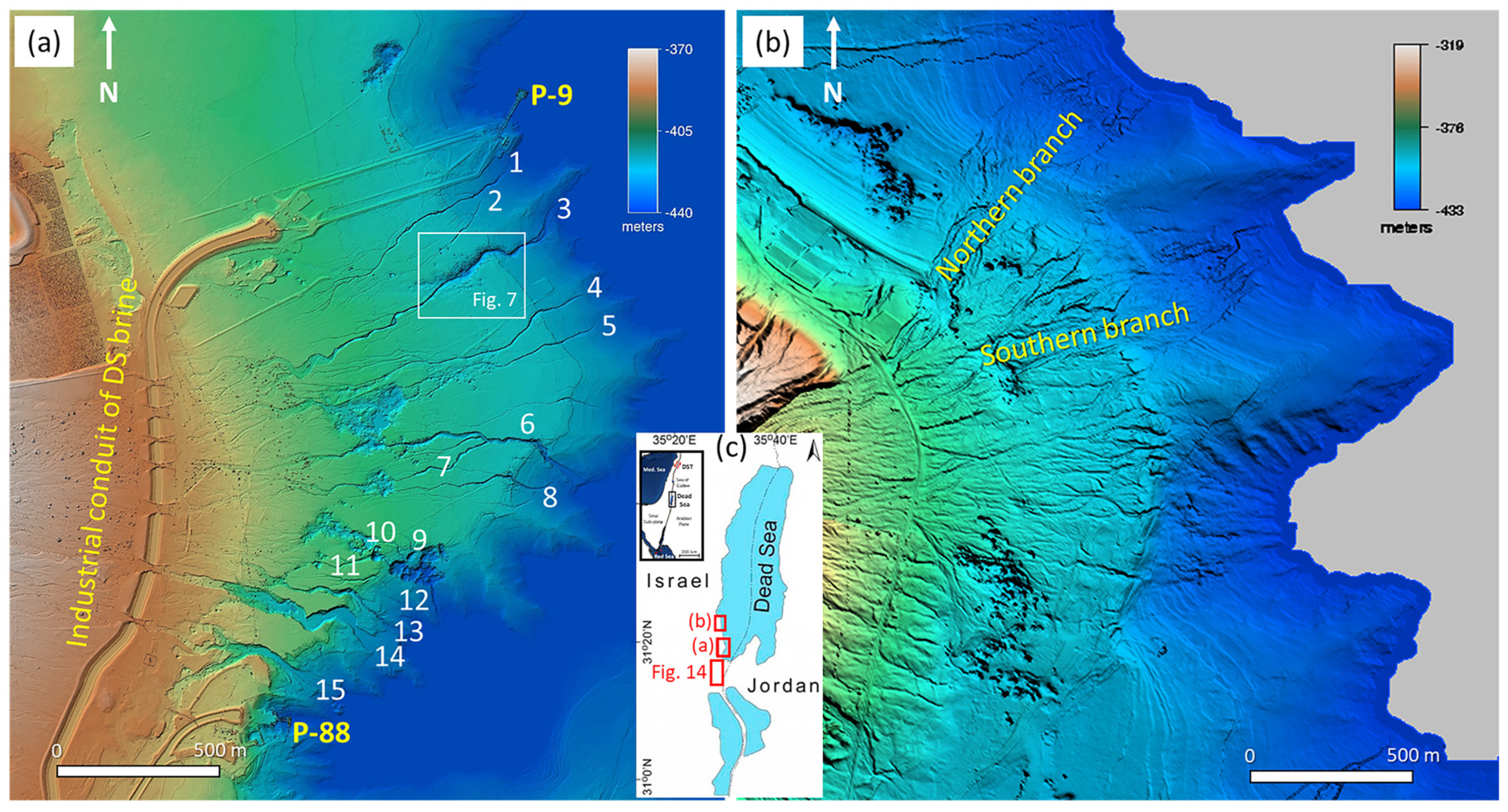

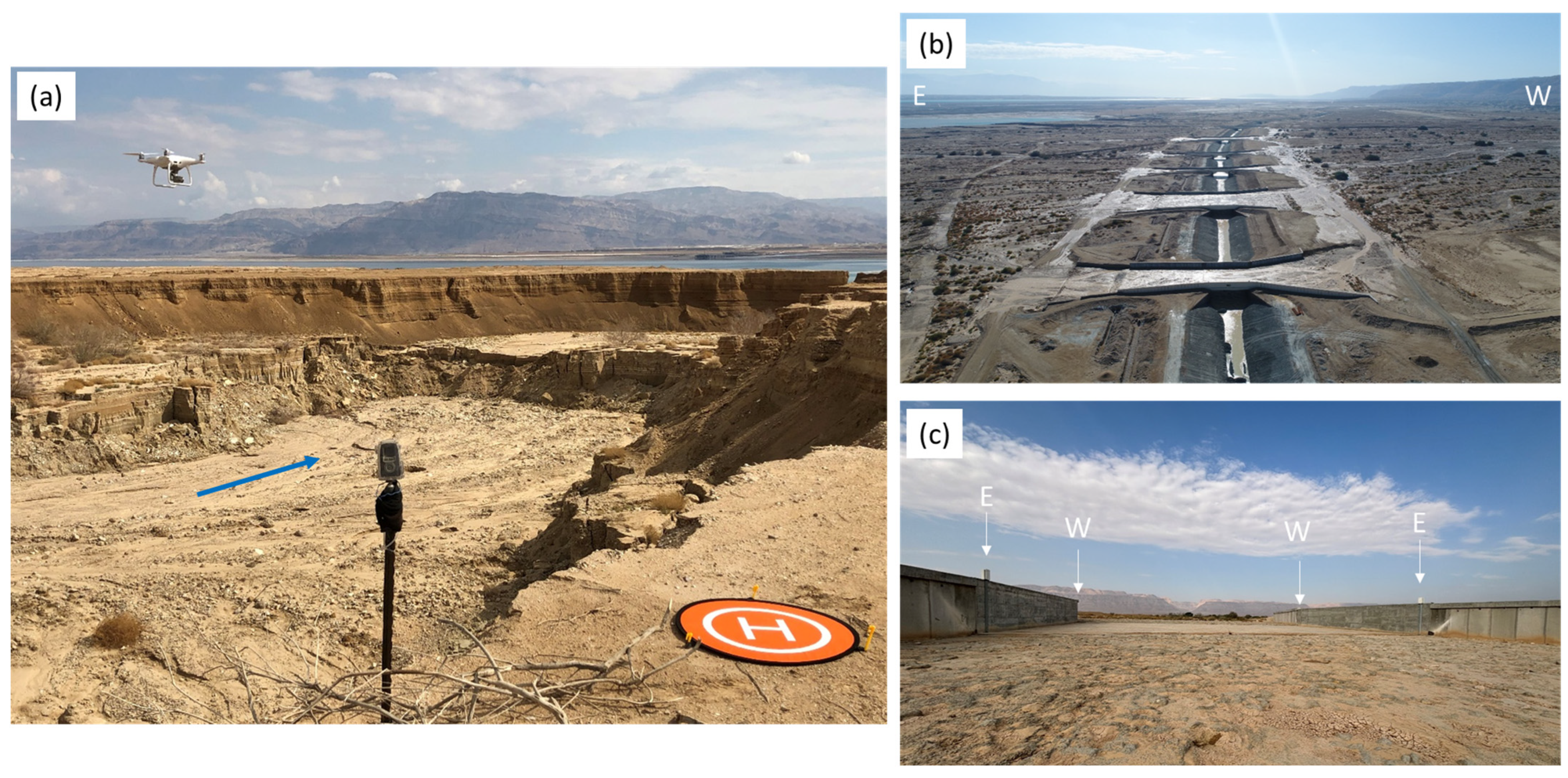


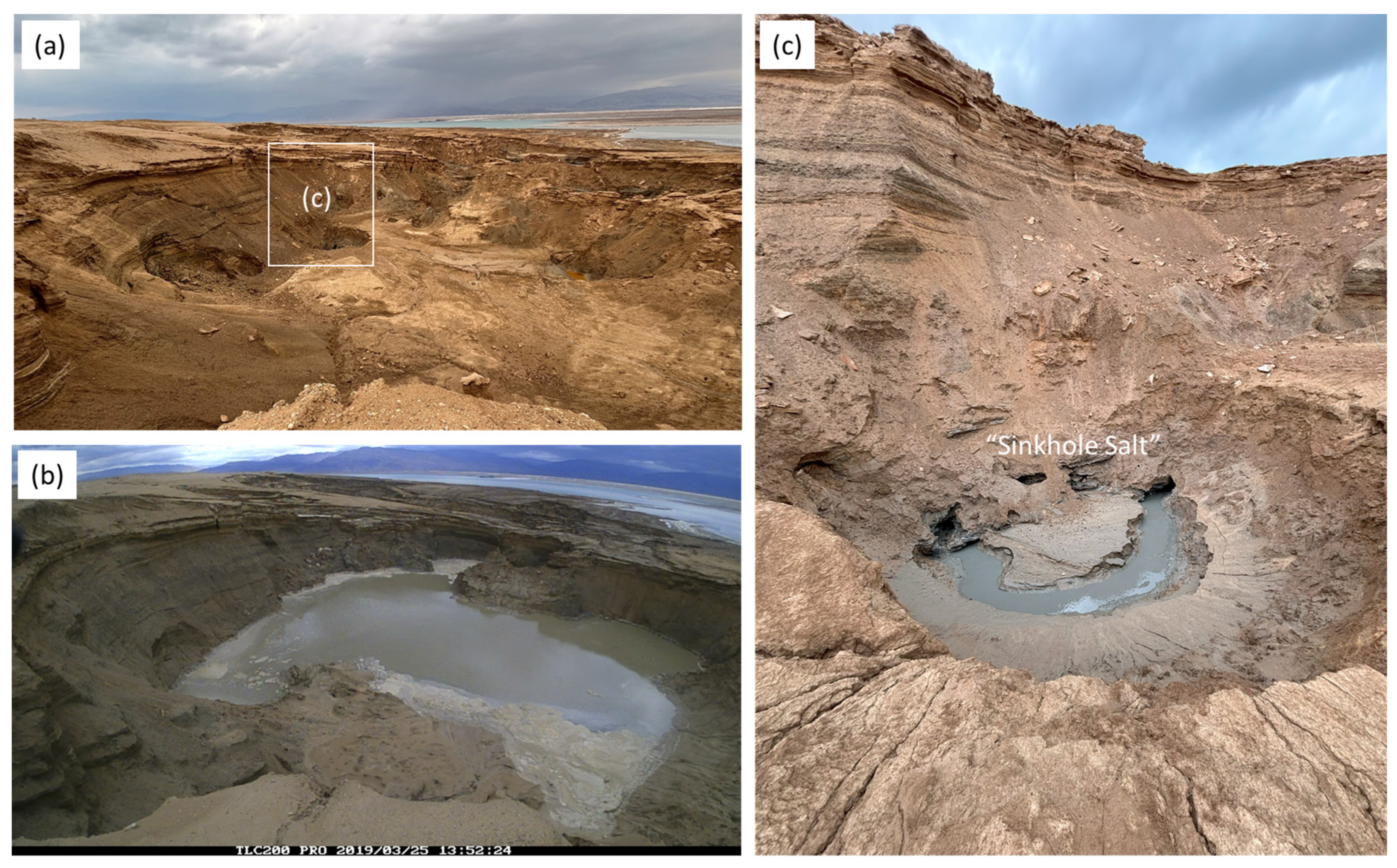

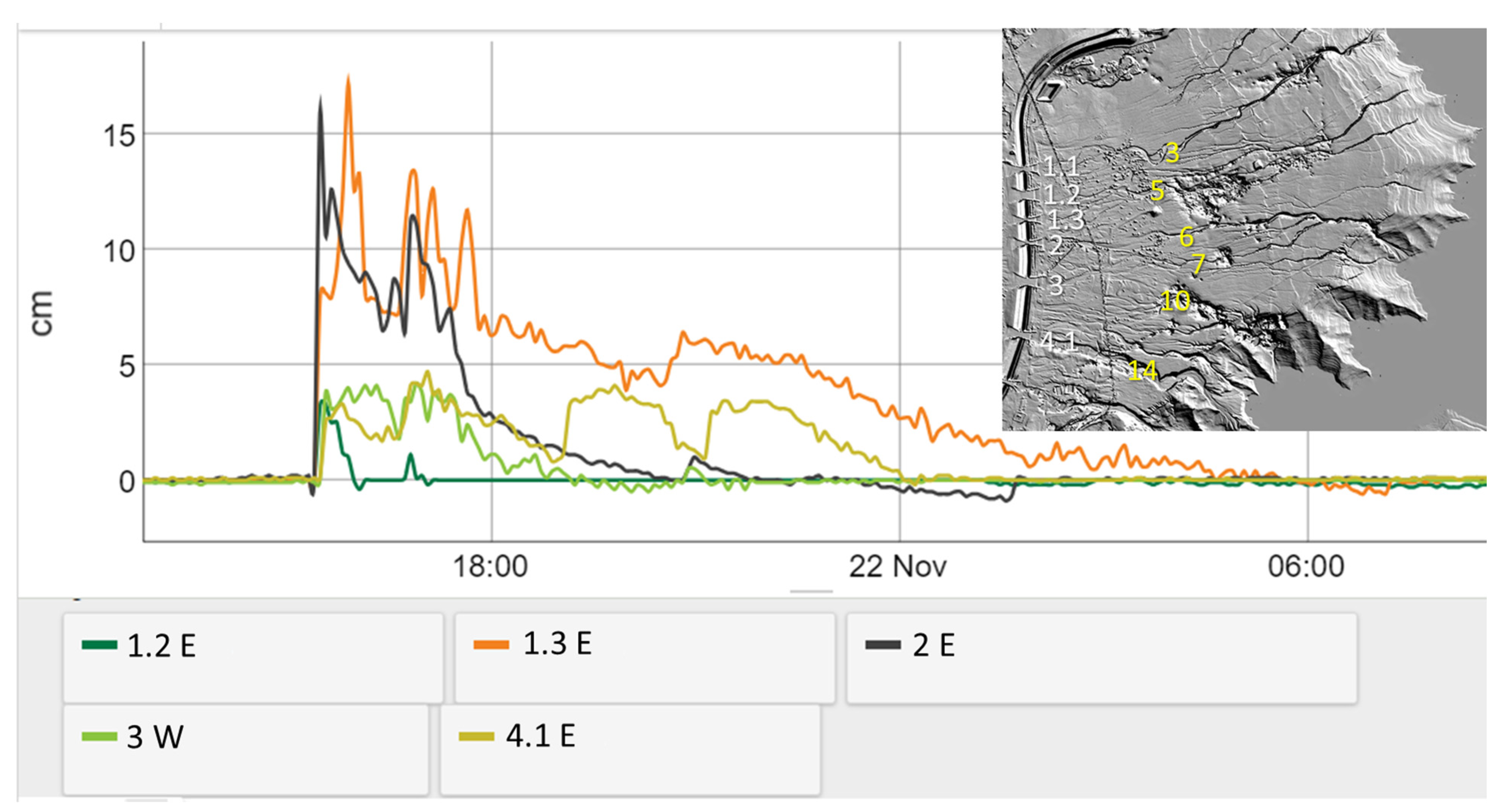
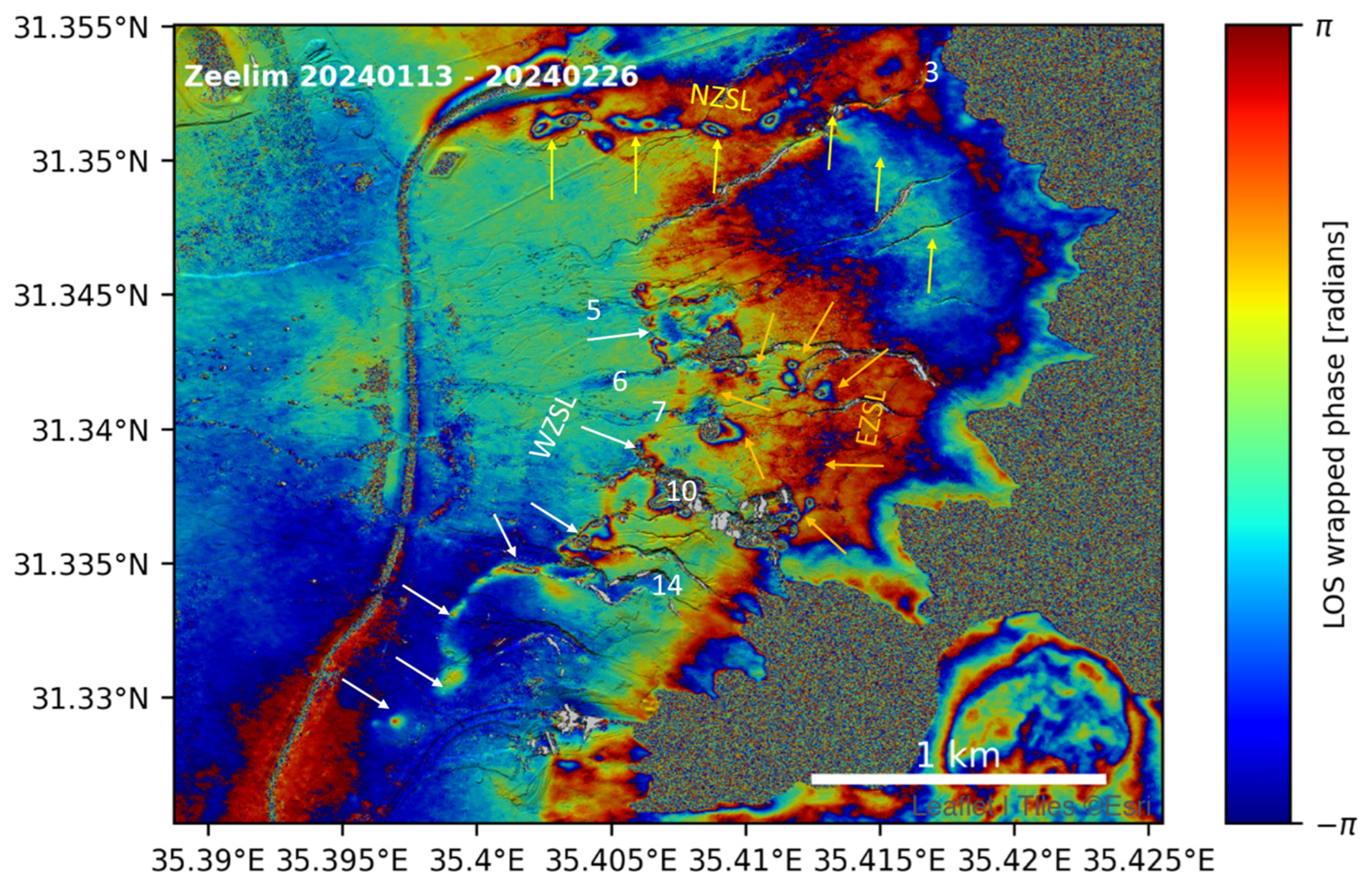
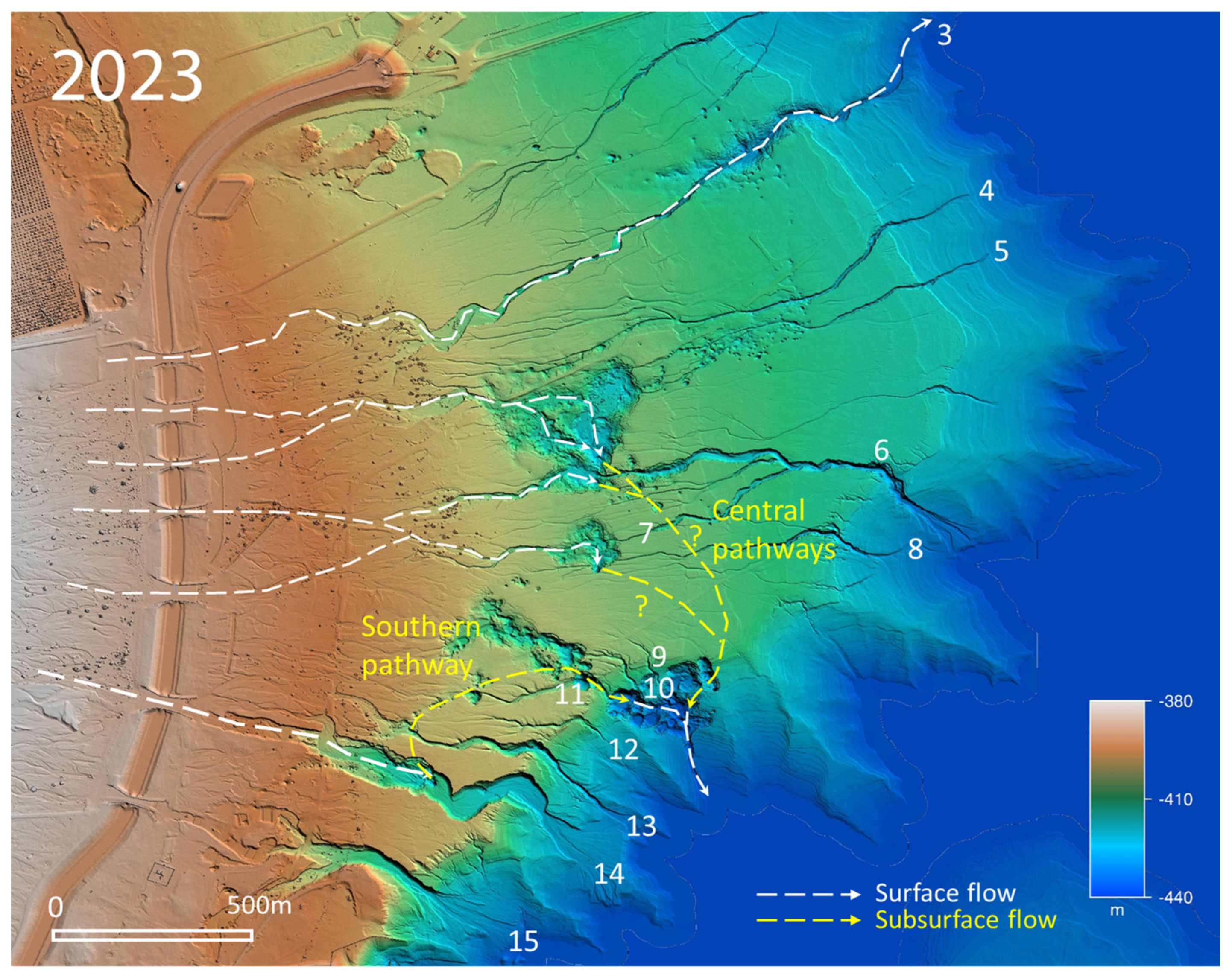
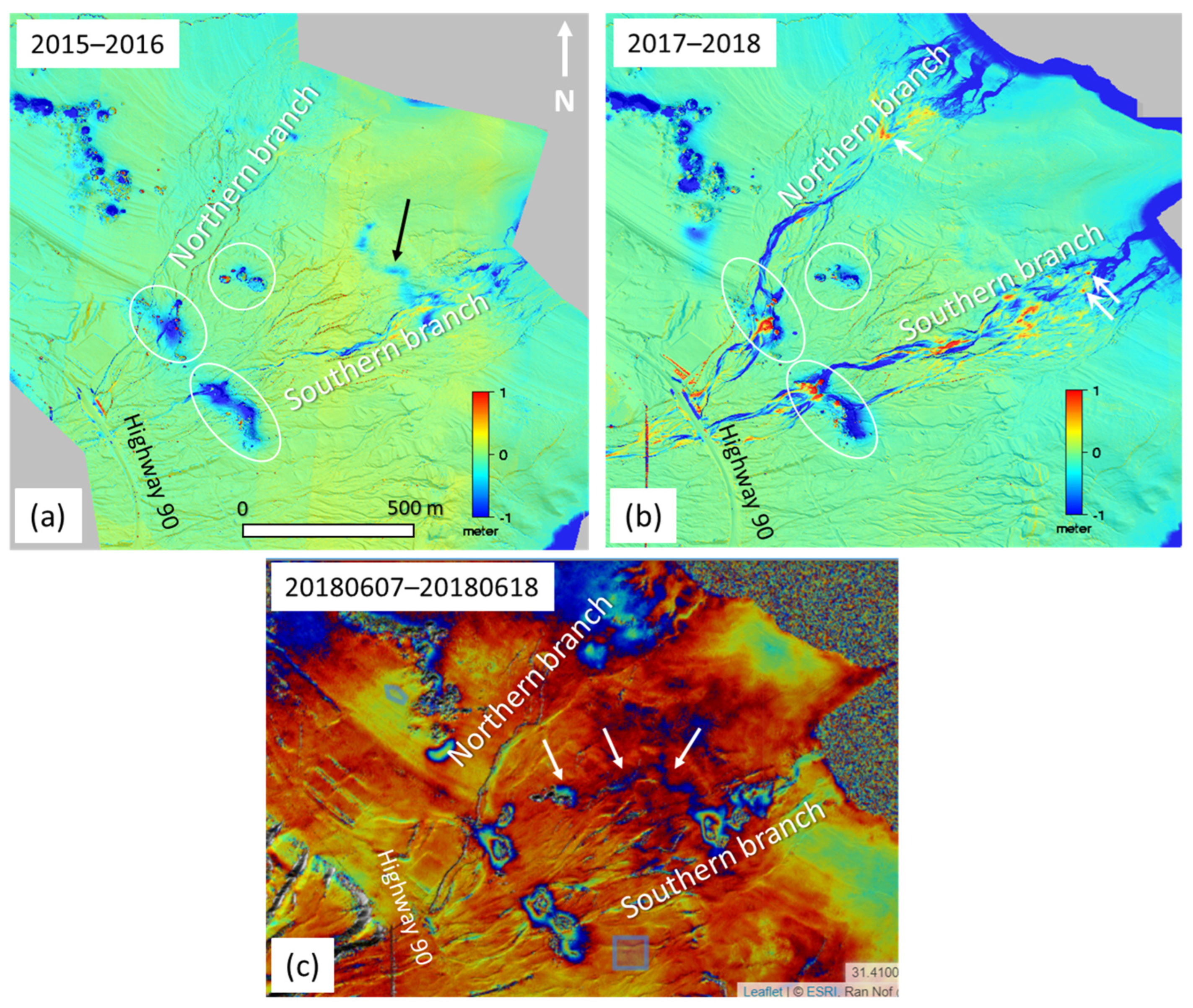
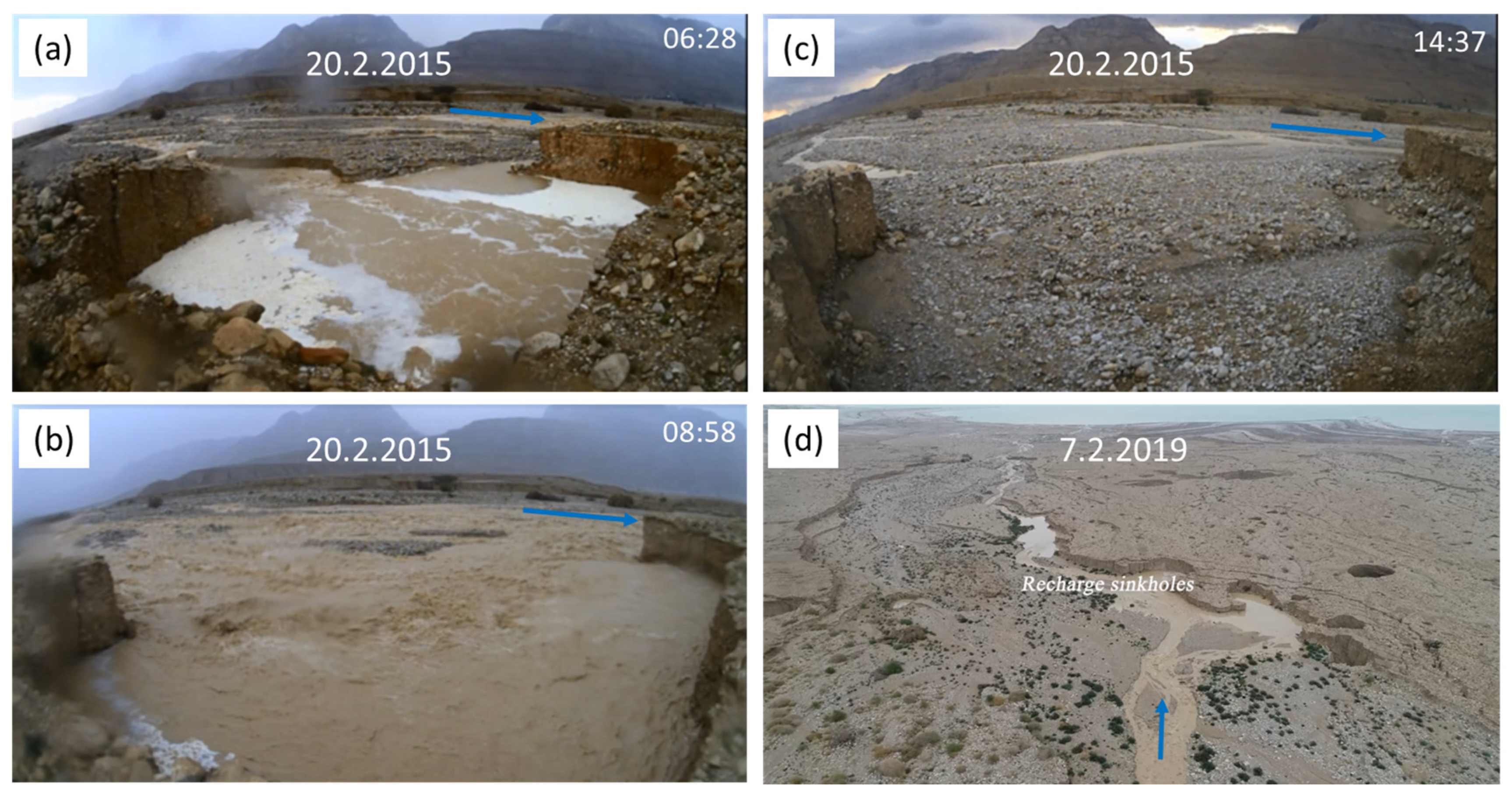
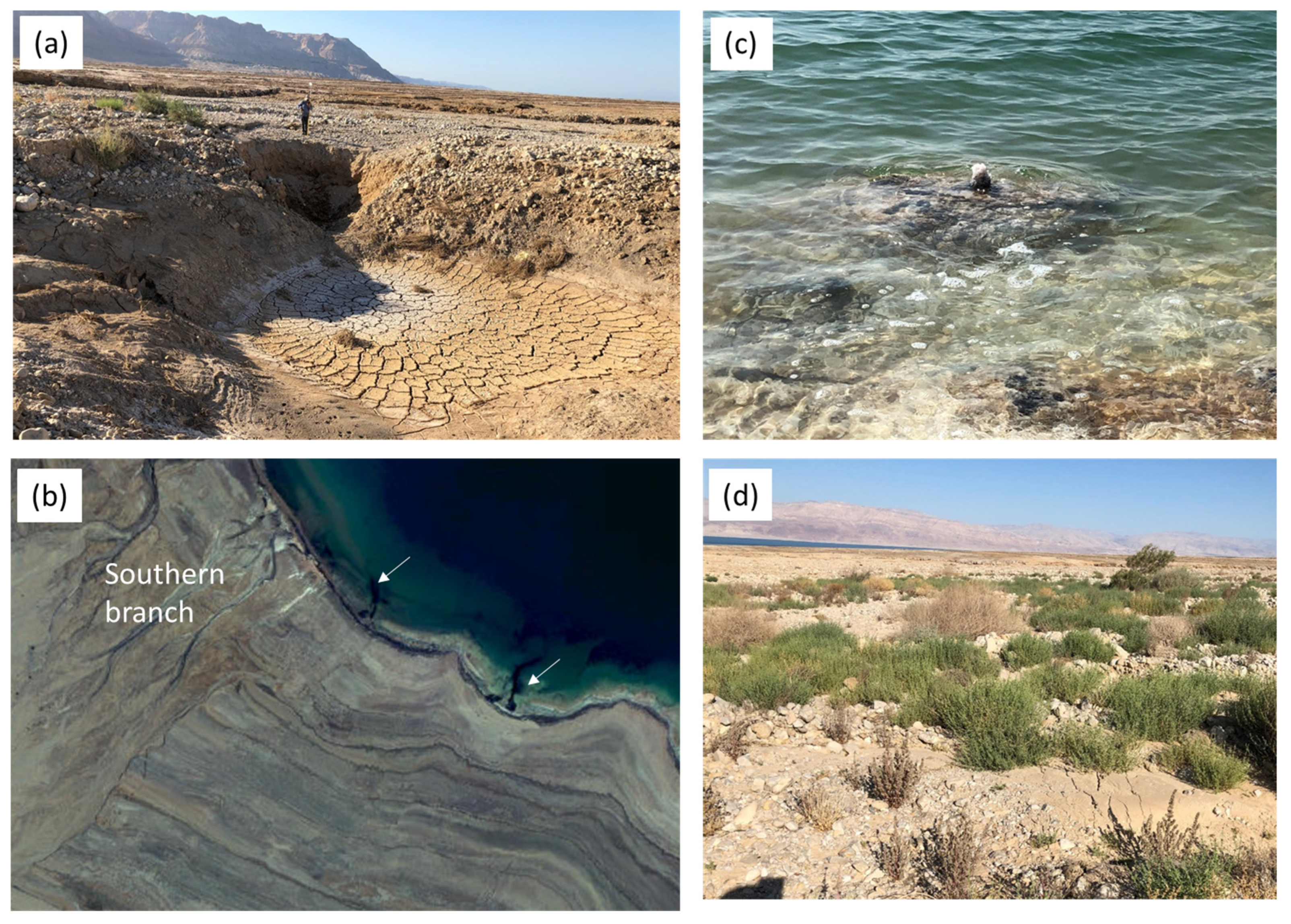
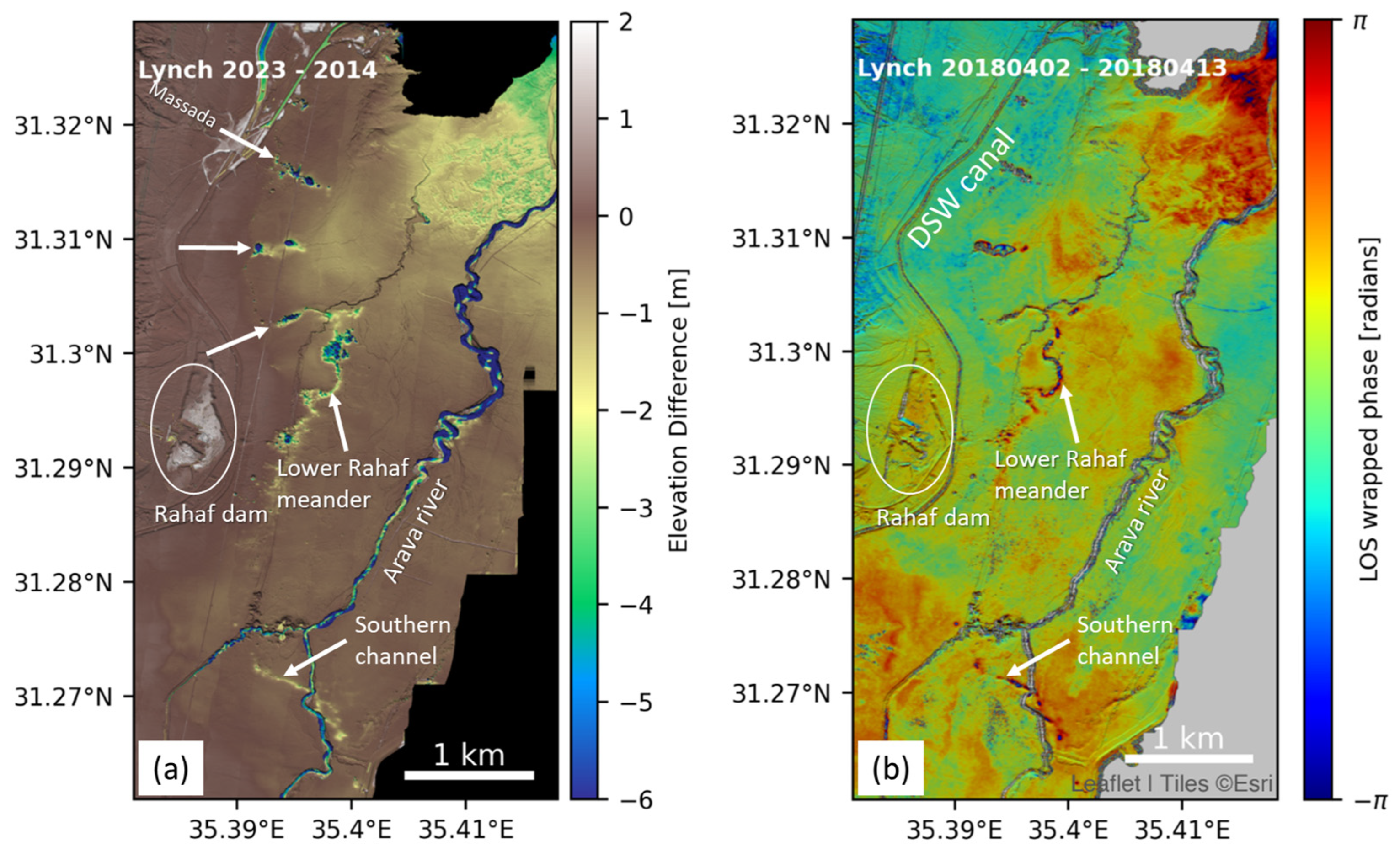
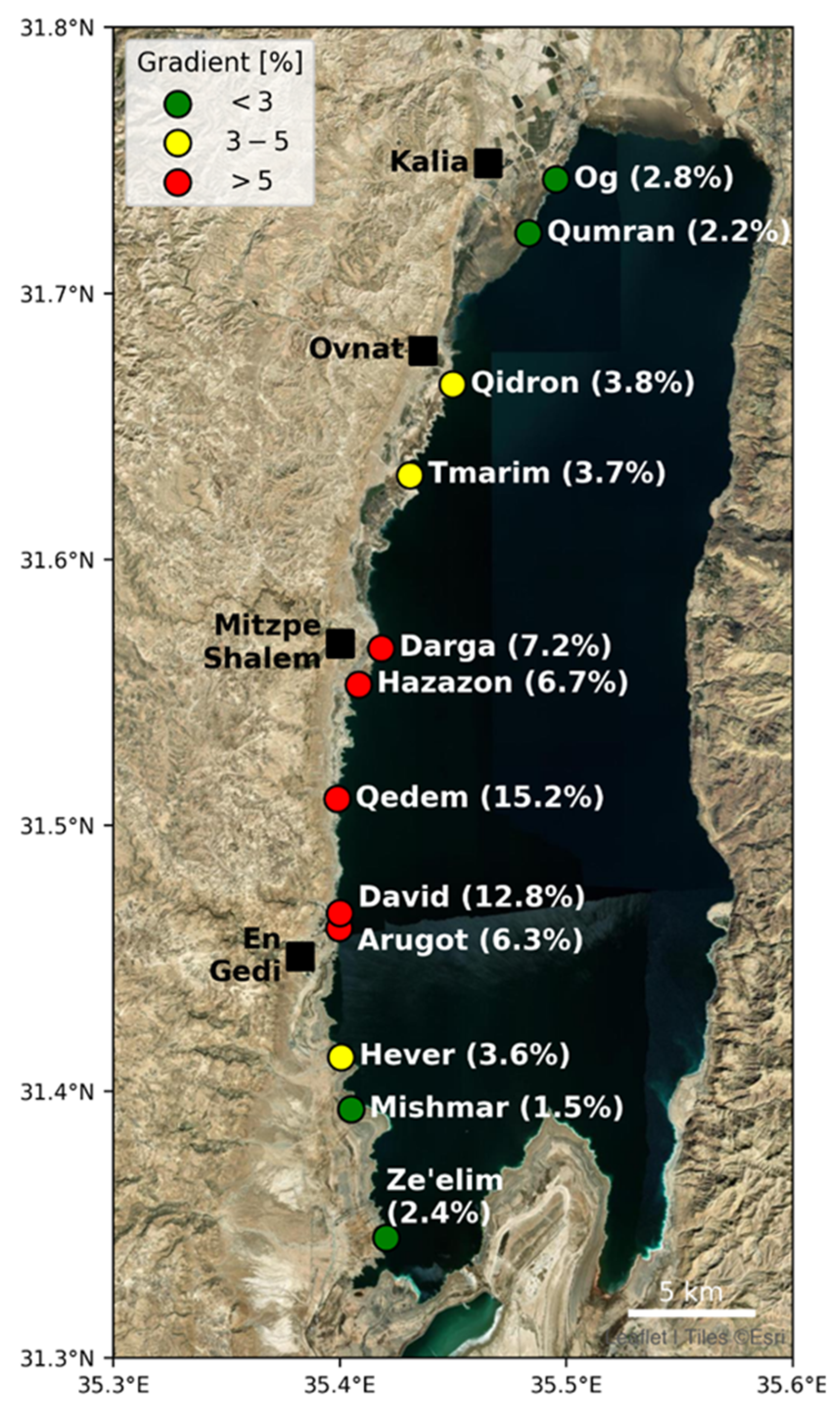
| 20.2.15 | 7.2.19 | 25.3.19 | 24.1.20 | 13.3.20 | 8.2.23 | 20.3.23 | |
|---|---|---|---|---|---|---|---|
| Time at hydrograph 1 | 07:55 | 08:30 # | 11:11 | 04:40 | 09:39 # | 04:10 | |
| Peak discharge 1 (m3/s) | 29.1 | 3.1 | 3.9 | 1.9 | 11.6 | 18.4 | |
| Recharge gully 5 | 08:35 | ||||||
| Recharge gully 14 | 09:00 | 09:30 # | 12:39 | 10:40 # | 05:27 | ||
| Recharge gully 7 | 07:10 | <05:30 * | 05:50 | ||||
| Recharge gully 6 | 05:21 | ||||||
| Discharge sinkhole 10c | 11:20 | ||||||
| Discharge sinkhole 10a | 10:15 | 10:40 # | 13:30 | 11:25 | 06:10 | ||
| Discharge sinkhole 10f | 09:52 | 13:24 | 08:00 | <05:30 * | 06:30 | ||
| Time from 5 to 10c (min) | 165 | ||||||
| Time from 14 to 10a (min) | 75 | 70 | 51 | 45 | 43 | ||
| Time from 7 to 10f (min) | 50 | 40 | |||||
| Time from 6 to 10f (min) | 69 |
Disclaimer/Publisher’s Note: The statements, opinions and data contained in all publications are solely those of the individual author(s) and contributor(s) and not of MDPI and/or the editor(s). MDPI and/or the editor(s) disclaim responsibility for any injury to people or property resulting from any ideas, methods, instructions or products referred to in the content. |
© 2024 by the authors. Licensee MDPI, Basel, Switzerland. This article is an open access article distributed under the terms and conditions of the Creative Commons Attribution (CC BY) license (https://creativecommons.org/licenses/by/4.0/).
Share and Cite
Baer, G.; Gavrieli, I.; Swaed, I.; Nof, R.N. Remote Sensing of Floodwater-Induced Subsurface Halite Dissolution in a Salt Karst System, with Implications for Landscape Evolution: The Western Shores of the Dead Sea. Remote Sens. 2024, 16, 3294. https://doi.org/10.3390/rs16173294
Baer G, Gavrieli I, Swaed I, Nof RN. Remote Sensing of Floodwater-Induced Subsurface Halite Dissolution in a Salt Karst System, with Implications for Landscape Evolution: The Western Shores of the Dead Sea. Remote Sensing. 2024; 16(17):3294. https://doi.org/10.3390/rs16173294
Chicago/Turabian StyleBaer, Gidon, Ittai Gavrieli, Iyad Swaed, and Ran N. Nof. 2024. "Remote Sensing of Floodwater-Induced Subsurface Halite Dissolution in a Salt Karst System, with Implications for Landscape Evolution: The Western Shores of the Dead Sea" Remote Sensing 16, no. 17: 3294. https://doi.org/10.3390/rs16173294
APA StyleBaer, G., Gavrieli, I., Swaed, I., & Nof, R. N. (2024). Remote Sensing of Floodwater-Induced Subsurface Halite Dissolution in a Salt Karst System, with Implications for Landscape Evolution: The Western Shores of the Dead Sea. Remote Sensing, 16(17), 3294. https://doi.org/10.3390/rs16173294






